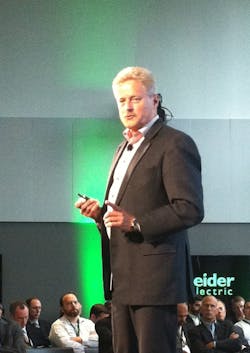Inside Schneider Electric’s Software Strategy
At the grand opening of Schneider Electric North America’s new Boston One campus, president and CEO Laurent Vernerey announced that, following the acquisition of Invensys this year, Schneider Electric now has the “portfolio we wanted to assemble” with a foothold in both the discrete and process automation businesses. Following Vernerey’s and other executives’ statements about the future direction of the company,I had an opportunity to discuss some of the points raised during their presentations.
One of those points involved Vernerey’s comment that he sees an “opportunity for Schneider Electric to close the efficiency gap” at the crossroads of connectivity, computing, and energy.
That opportunity exists in PlantStruxure, explains Clemens Blum, executive vice president of Industry Business at Schneider Electric. The key to energy control, he says, “is to collate energy with production data to normalize it so that you can understand energy consumption related to units produced. Then you have a clear understanding of energy use and can use it for benchmarking shifts, facilities, and equipment to determine waste issues.”
Schneider Electric also acquired specific metering and data collection capabilities with IMServe via the Invensys purchase, adds Greg Conary, senior vice president and head of strategy for the Industry Business sector at Schneider Electric. “With this technology you can get the granularity of data” needed for effective energy use analysis and management. Plus, advanced process control (APC) is all about energy management, and Schneider Electric now has that in its portfolio from Invensys’s SimSci ROMeo.
Schneider Electric now has “strength stretching from PLC to DCS,” says Conary. Having the ability and expertise to leverage the “connectivity of those two types of systems” allows us to bring a “total systems feel from the PLC out to the safety system.”
During his time on stage at the Boston One opening event, Pascal Brosset, chief technology officer for Schneider Electric, noted that a major factor driving the company’s technology strategy is that “we are reaching the limit of traditional architectures.” In relation to this, he made special note of Schneider Electric’s increasing focus on a new system on chip (SoC) that will play a role in the company’s new products moving forward. Bringing this level of intelligence out to, potentially, every field device plays a big role in the company’s move to support the Internet of Things concept as the groundswell of interest around this concept increases.
Brosset explains that Schneider Electric’s approach here, of encapsulating the control layer on an SoC and deploying it to enable IoT capabilities—rather than bringing the Internet into the control layer—is a critical differentiator designed to protect the security and integrity of the control system.
To give an example of how this is already being done, Brosset references building control systems. Think of a building management system like a PLC, he says. To optimize that building’s performance without retrofitting the entire building management system from the PLCs to the end devices (in this case, wired thermostats), you deploy sensors that can operate autonomously on a solar cell with an RFID chip that measures temperature, light, and humidity. Then you stream this data from the sensors through gateways to feed into the building management system. In this way, you can keep the legacy system intact and complement its function with additional measurements points to optimize its operation.
Beyond the technical capabilities of having a controller embedded on a chip in the device itself, Brosset says that putting an SoC in all its devices has business implications for the company as well.
“As everything gets connected, we are being pushed into the service space,” Brosset says. “Before, we would deliver product into a channel without having to know exactly what users did with it. But now we can connect directly to the end user to service the device.”
The implications of this run from an equipment servicing model, that Brosset likens to GE’s new Equipment Insight offering, to a business model like Apple’s, where having the “app store is enough to sell you a $600 phone.”
How this will play out long-term for Schneider Electric remains to be seen. As Brosset says, “Our system analytics detect failure, but we’re not the guy with the screwdriver.” However, given the new direction of the automation business (i.e., to provide service for equipment sold), there is “no disintermediation” in the eyes of the customer, he says.
About the Author
David Greenfield, editor in chief
Editor in Chief

Leaders relevant to this article:
